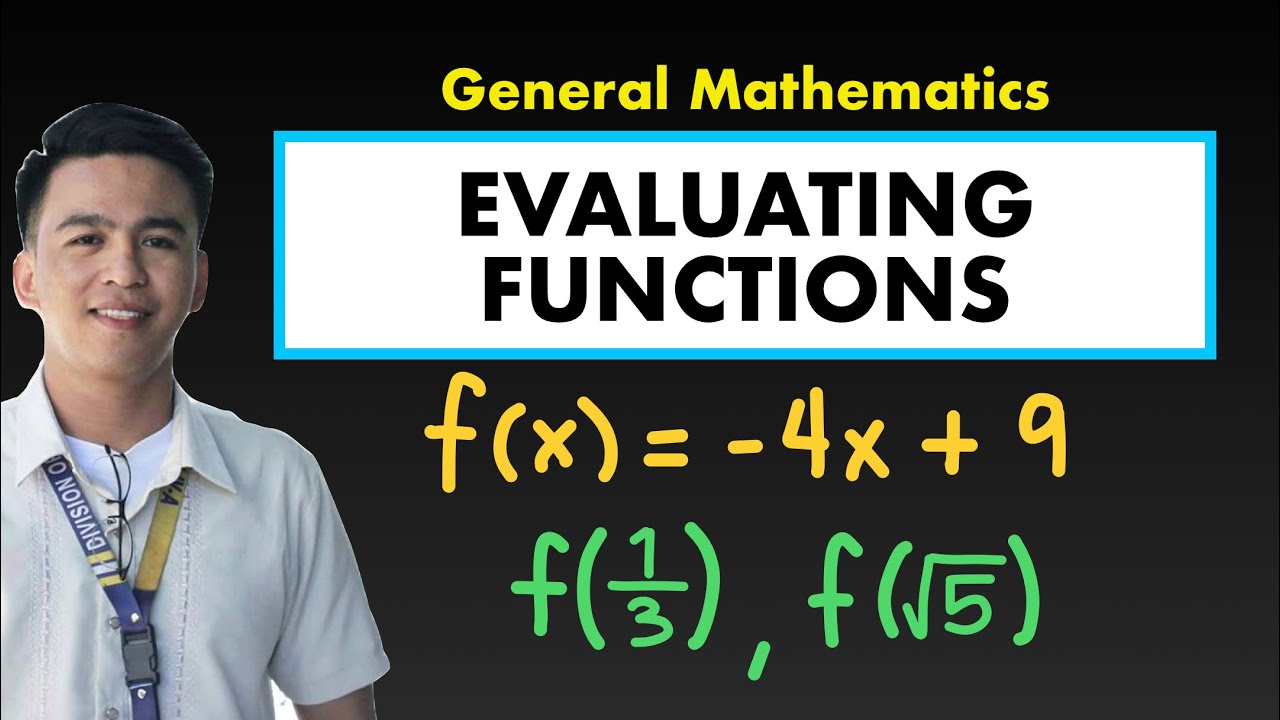Grade 11 | Evaluating Functions | General Mathematics
Summary
TLDRIn this educational video, the host guides viewers through the process of evaluating functions by substituting given values for variables. The tutorial covers various examples, including simplifying expressions, dealing with square roots, and handling rational functions. Each step is explained with clear instructions, ensuring viewers can follow along and understand how to find the output of a function for a specific input. The host's engaging teaching style makes learning mathematical concepts accessible and enjoyable.
Takeaways
- 📚 The video is a tutorial on evaluating functions by substituting specific values for the variable.
- 🔢 The first example demonstrates how to find the value of a function when x is substituted with 4, resulting in g(4) = 13.
- 📐 The second example involves a square root function where h(2) is calculated, leading to a simplified radical form.
- ✅ The third example is a rational function where the value k(-3) is found by substituting x with -3, resulting in k(-3) = -13.
- 🔄 In the fourth example, a polynomial function is evaluated by substituting x with 5x - 2, yielding a quadratic function.
- 📈 The final example shows how to evaluate an exponential function for x = 3/2, resulting in g(3/2) = 8.
- 👨🏫 The tutorial is presented by Prof D, who guides viewers through each step of the function evaluation process.
- 💡 The video emphasizes the importance of following the order of operations (PEMDAS) when simplifying expressions.
- 📝 The script includes a step-by-step breakdown of each function evaluation, making it easier for viewers to follow along.
- 🤔 The video encourages viewers to ask questions or seek clarifications in the comments section if they need further help.
Q & A
What is the value of g(4) in the function g(x) = 5x - 7?
-The value of g(4) is calculated by substituting x with 4 in the function g(x) = 5x - 7. So, g(4) = 5*4 - 7, which simplifies to 20 - 7, resulting in g(4) = 13.
How do you find h(2) for the function h(t) = sqrt(t^2 + 2t + 4)?
-To find h(2), substitute x with 2 in the function h(t) = sqrt(t^2 + 2t + 4). This results in h(2) = sqrt((2)^2 + 2*2 + 4), which simplifies to sqrt(4 + 4 + 4) = sqrt(12). Since 12 is 4 times 3, h(2) equals 2sqrt(3).
What is the result of k(-3) for the rational function k(x) = (3x^2 - 1) / (2x + 4)?
-For k(-3), substitute x with -3 in the function k(x) = (3x^2 - 1) / (2x + 4). This gives k(-3) = (3*(-3)^2 - 1) / (2*(-3) + 4), which simplifies to (27 - 1) / (-6 + 4), resulting in 26 / -2, which equals -13.
What is the polynomial function for f(5x - 2) in the expression f(x) = 2x^2 + 5x - 9?
-To find f(5x - 2), substitute x with (5x - 2) in the expression f(x) = 2x^2 + 5x - 9. This results in f(5x - 2) = 2(5x - 2)^2 + 5(5x - 2) - 9, which expands to a quadratic function in terms of x.
How do you calculate g(3/2) for the exponential function g(p) = 4^x?
-For g(3/2), substitute x with 3/2 in the function g(p) = 4^x. This results in g(3/2) = 4^(3/2). Since the exponent is in the denominator, it's equivalent to the square root of 4 raised to the power of 3, which is 2^3, giving g(3/2) = 8.
What is the significance of substituting values into functions as demonstrated in the script?
-Substituting values into functions allows for the evaluation of the function at specific points, which is essential for understanding how the function behaves and for solving problems where specific outputs are required for given inputs.
How does the process of substitution help in simplifying expressions involving functions?
-Substitution simplifies expressions by replacing variables with specific values, which allows for the calculation of the function's output at those values, making it easier to understand the function's behavior and results.
What is the importance of following the order of operations (PEMDAS/BODMAS) when evaluating functions?
-Following the order of operations ensures that calculations are performed correctly, especially when dealing with functions that involve multiple mathematical operations such as addition, subtraction, multiplication, division, exponents, and roots.
Can you provide an example of how to handle a binomial raised to a power in a function?
-Yes, an example is shown in the script where (5x - 2)^2 is expanded to 25x^2 - 20x + 4. This is done by squaring each term in the binomial and then combining like terms.
What is the final result of f(5x - 2) from the script's example?
-The final result of f(5x - 2) is a quadratic function that simplifies to -15x^2 - 11x - 9 after expanding and combining like terms.
Outlines

This section is available to paid users only. Please upgrade to access this part.
Upgrade NowMindmap

This section is available to paid users only. Please upgrade to access this part.
Upgrade NowKeywords

This section is available to paid users only. Please upgrade to access this part.
Upgrade NowHighlights

This section is available to paid users only. Please upgrade to access this part.
Upgrade NowTranscripts

This section is available to paid users only. Please upgrade to access this part.
Upgrade NowBrowse More Related Video

EVALUATING FUNCTIONS || GRADE 11 GENERAL MATHEMATICS Q1

Evaluating Functions - Basic Introduction | Algebra

Evaluating Functions with Value of X as Fraction and Radical | General Mathematics

VALOR NUMÉRICO DE UN POLINOMIO Super facil -Para principiantes

Matematika SMA - Sistem Persamaan Linear (6) - Sistem Persamaan Linear Tiga Variabel (A)

SPLDV (Sistem persamaan linear dua variabel) Metode grafik
5.0 / 5 (0 votes)